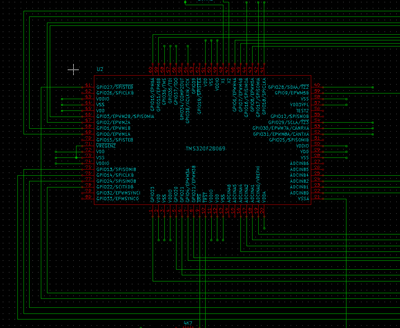Power Electronics Construction Set
downloads
Community
- KiCAD on Facebook - [1]
Presentation
This is the working document under development:
Session 2
Microcontroller. File:GenericMCU.pdf.
Session 3
- Auxiliary power supply. This applies to welder, plasma cutter, induction furnace.
- Circuit: File:Internalpowersupply.pdf
Session 4
October 7, 2015.
Session 5
October 14, 2015
Session 6
October 21, 2015
Calculations - File:Weldercalc.pdf.zip
Session 7
October 28, 2015
Calculations for Power Factor Correction - File:PfcD.pdf.zip
Calculations for Phase Modulator - File:Modulator.pdf.zip
Overview
The power electronics pattern language is the language that allows the composition of a Universal Power Supply – a device that powers any electrical devices such as: induction furnace, welder, laser cutter, plasma cutter, inverter, converter, charger, wind turbine charge controller, electric motor controller, and others. The Power Electronics Construction Set (PECS) is the set of techniques and tools for building such a Universal Power Supply. The pattern involved is:
Inverter
- Convert any VDC to VAC - 1kW supply, scalable.
- Two main types, pure sine wave or modified sine wave. Modified is more simple and economical, pure sine is more universal (i.e. able to power computers and sensitive equipment) and delivers more power to the load, but is a little more costly and complex. An old-school method is to run a DC motor that runs an AC generator through a mechanical linkage, not as efficient, but dirt simple.
- Existing Info on PECS Inverters
- A well documented Pure Sine Wave example explaining the sub-circuits.
Details
- Allowance for quick-connect input and output of electrical power of any magnitude, including DC and AC of any frequency
- All functionality occurs via plug-in 'black boxes' of functionality
- All control of current, voltage, frequency, and timing occurs internally via a number of modules with quick-connect inputs and outputs
- Current and voltage magnitude scaling is achieved by plug-in addition of components, such as transistors
- Repair of sensitive components is achievable via plug-in of components
- Mechanical clamp-down secures sensitive components and heat sinks
- Scalable cooling mechanism is achieved via plug-in fans or liquid cooling.
See Also
Sep 16, 2015
From Brandon of Element 14 - Community Manager.
Hi Brandon,
This would be a great opportunity. We are working on a Power Electronics Construction Set - a set of modules to build inverters, welders, plasma cutters, induction furnaces, motor drives, and more. We could use help with parts and design effort for specific implementations. We are working on this as part of our open source industrial fab lab.
Initial notes on Power Electronics Construction Set:
https://docs.google.com/presentation/d/12BoFUgl0TMe3cY00gU-eRSc5reZ7D_RyPtqX5kTJNKQ/edit
We are continuing this weekly to work out implementation of each component, but high focus on a construction set appraoch.
What are your thoughts?
Marcin
2012
On Thu, Sep 27, 2012 at 9:43 AM, Pierre Michael wrote: Sure. It's not my area of expertise, but I can certainly research it. There are dedicated chips for producing sine waves. Any restrictions on part or board complexity?
Heatsink design is important when designing these types of power supplies. A mechanical engineer may be better at tackling that portion.
Does it matter which ECAD tools I use? I suspect I should use Eagle since it's the free tool.
Free and open tools are preferable.
Also, by scalable, do you mean putting supplies together in parallel, or swapping out components for higher power versions?
I am thinking more about parallel operation in phase with one another - but another option would be also swapping components or adding components.
The way I see it - have a uniform brain unit - and plug as many power stages to it as needed in parallel, or plug in a single large power stage.
The design should be optimized for lifetime design - you can swap burnt components easily. I am really thinking about universal 'funcional modules' such as sine generator, power stage - basically - if we do a breakdown diagram of functions - these functions may be reused in different applications: welders, induction furnace, plasma cutter, etc.
So the highest level of modularity is best - for a 'power electronics construction set.'
MJ
Links
- Open source 250W inverter - [2]
